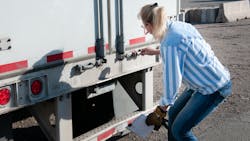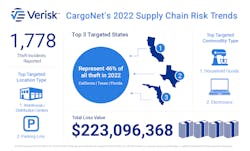As cargo theft continues to rise, experts advise on prevention and spotting fraud
Shippers and carriers should be vigilant as new data shows 2022 saw an increase in cargo theft from the year prior, and experts indicated it's a trend that shows no signs of slowing.
Theft prevention and recovery network CargoNet has reported that almost 1,800 theft claims were made by its members last year—an increase of 15% from 2021, which saw fewer than 1,300 incidents reported.
“You’re coming out of 2022 with severe momentum,” said Scott Cornell, transportation lead and crime and theft specialist at Travelers, adding that the data has been heading in this direction for several quarters.
“The amount of stuff that’s going on right now, it’s just fast," he said. "Very intense, very frequent.”
The most-targeted locations have changed, as well. Truck stops were the highest-risk areas in 2021, followed by warehouses and distribution centers. In 2022, warehouses and distribution centers took the top spot, with parking lots coming in second.
Danny Ramon, intelligence and response manager at supply chain risk management company Overhaul, noted an increase in high-value pilferages when cargo is stolen from a trailer, as opposed to the trailer itself being stolen.
Ramon said that pilferage used to usually be “maybe 10% [of cargo from] a 53-ft. trailer. Now we’re seeing upwards of 90-plus percent.”
See also: 'Pilferage' now the crime of choice among cargo thieves
What are cargo thieves stealing, and where?
There also has been a rise in “strategic theft,” Ramon said, which is when thieves use fraudulent or stolen carrier or driver identities to book and then steal loads. Strategic theft has historically been most prominent in Southern California, Ramon said, but the trend has begun to creep eastward.
“One of the things that we are starting to see, and I predict is going to be a long-term trend, is the shift of strategic and fraudulent thefts,” Ramon said, “moving to the East Coast and more eastern states. We’ve seen it start already in Indiana and Illinois, as well as Georgia and a couple of other East Coast port cities.”
This increase in strategic theft eastward follows an increase in shipping container traffic to eastern states, Ramon said, as cargo theft follows cargo density. Another factor making those areas a riper target is that, because they don’t traditionally see as much strategic theft, many shippers and brokers out east do not vet their carriers as thoroughly, making it easier to fraudulently obtain loads, he said.
Due to the increase in strategic theft, Ramon and Cornell underscored the importance of shippers and brokers preventing theft through thorough vetting.
Additionally, carriers can assess risk themselves by checking their freight and the lane in which they will be hauling it against the data.
“The numbers are extremely important, but pay attention to more of the trends—in the commodities, the locations,” said Keith Lewis, CargoNet’s VP of operations, who also worked in law enforcement for 24 years. Carriers must focus on their loads that travel through the most high-risk areas with the cargo that is most likely to be targeted.
See also: Gallery: Trucker safety guide and statistics for 2023
”The golden rule for cargo theft is that they’re going to steal what they know they can sell,” Cornell said. Thieves steal to supply what is in demand as the economy fluctuates. In a stronger economy, luxury items, such as electronics and computers, are stolen more often. Essentials such as food are stolen more often during economic hardship.
In 2022, household goods were the most commonly stolen item, a trend that began in the pandemic when everybody was at home, working or building home offices and gyms. Electronics—always lucrative—were the second-most popular targets, especially during chip shortages. Food and beverage weren’t far behind, according to CargoNet data.
How motor carriers, brokers, and shippers can protect their cargo
If drivers must travel through a high-risk area with high-risk cargo, they should plan their route as not to stop in those dangerous zones, said CargoNet’s Lewis. If they are operating in a high-risk area, they should allot time to be fueled, rested, and fed before picking up the load, so they can haul that freight out of the area without stopping.
During the vetting process, having a photo of the truck with a record of its DOT number and VIN is invaluable to law enforcement.
Overhaul’s Danny Ramon has seen cases where a driver doesn’t match the photo in the CDL he presents and even times where the DOT number on a truck is printed on a sheet of paper and attached to the side. Cases such as these, which would be obvious after even the most cursory investigation, can still result in theft if the company’s culture does not emphasize a vetting process, allowing thieves to successfully defraud shippers.
A more subtle indication of a fraudulent pickup would be an operator using a day cab for what is supposed to be a long haul.
“We’ve seen people showing up at an origin in California for a load booked to go all the way to Florida in a day cab which does not have a back seat, let alone a bed or a bunk," Ramon said. "And nobody’s asking questions like, ‘Are you really driving that three days all the way to Florida?’”
See also: Fleet executives detail successful safety strategies
Cornell of Travelers suggests, for those who offer to take high-value loads, looking up carriers on FMCSA’s website. He cited the example of a too-good-to-be-true offer of a carrier claiming it has so much capacity that it can send nine trucks to haul the load at a low rate, but that carrier has only two power units listed on its FMCSA page.
Cornell also recommended getting the phone number of drivers who pick up high-value loads. While it’s not possible to get the cell number of every driver, which further heightens the importance of vetting carriers before freight is taken, high-target commodities traveling through high-target areas should dictate open communication with the driver.
“If they say, ‘No, we’re not going to let you call the driver,’” Cornell added, "is that because they have a legitimate company policy in place? And then, OK, maybe you can work something else out with them. Or is it because you’re getting a feeling in your gut that they don’t want you to have contact information?”
Cornell said locks, despite their apparent simplicity compared to higher-tech solutions such as telematics monitoring, are “underrated,” citing landing gear locks for trailers, kingpin locks for fifth wheels, and air-cuff locks for brakes as options.
“Cargo thieves do not want to spend 20 minutes grinding through a lock,” Cornell said. “They want something they can be able to take quickly and be off-site quickly,” he said.
Cornell added that parking in a well-lit location that isn’t isolated would further reduce the likelihood of thieves attempting to break a lock. (At truck stops—the most-targeted location in 2021—drivers should be aware that the only cameras are pointed toward the pumps, not the lots, Lewis said.)
In addition to tracking trailers, fleets can also hide covert tracking devices within high-value cargo itself in case thieves move the freight from one trailer to another.
Regardless of what technologies a fleet uses, carriers, brokers, and shippers should always be prepared for the possibility of theft, staying informed on the latest trends and ensuring their entire organizations are aware of risks.
“The best weapon that you have for recovering is a network. Both a network of people who are doing the compliance monitoring,” Ramon said, “as well as, when it comes down to the recovery team, having a network of industry professionals.”
About the Author
Scott Keith
Scott Keith is a former fleet owner digital editor, who was on staff from 2022 to 2023.


